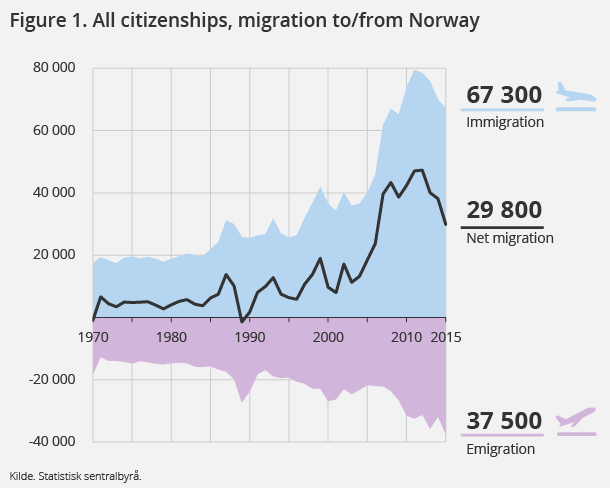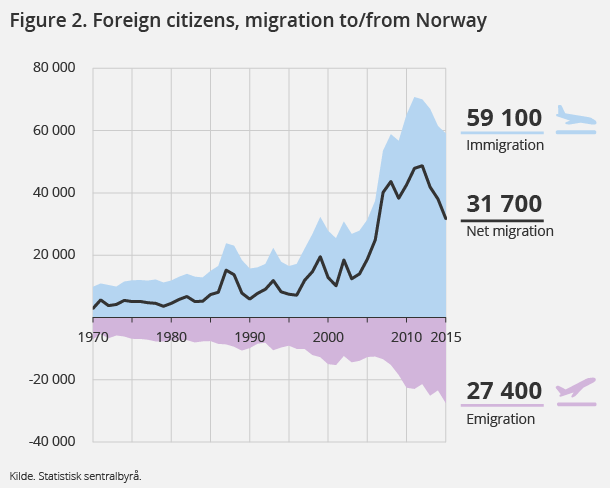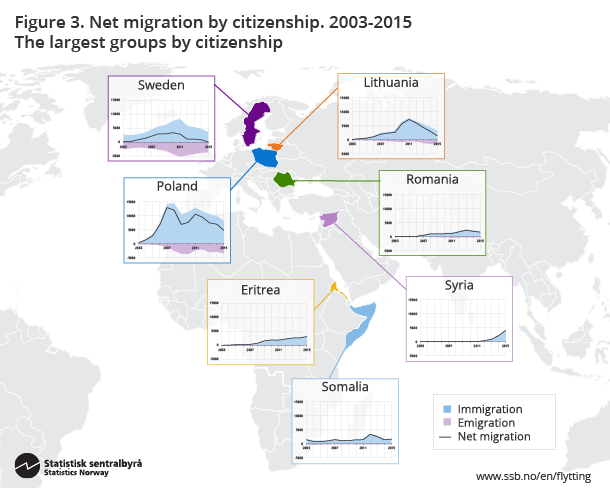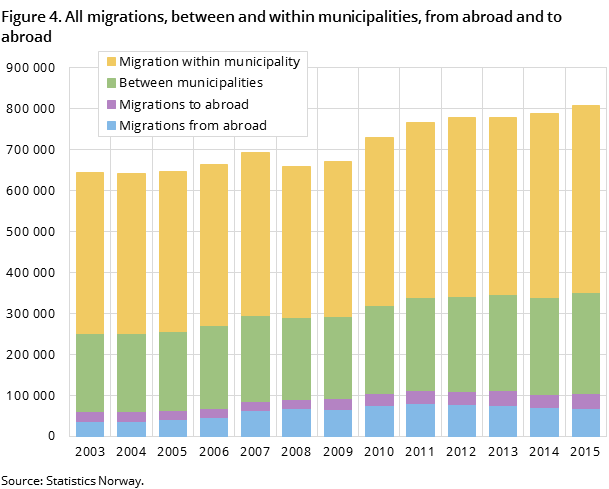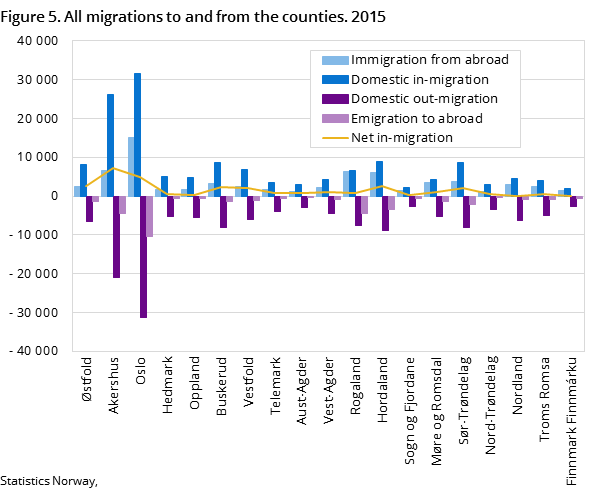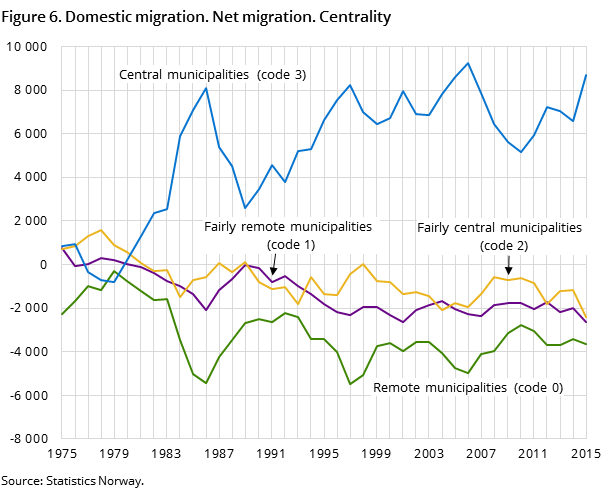Content
Published:
This is an archived release.
Fewer Europeans came, while more left
Net immigration to Norway in 2015 was 8 300 lower than the year before, primarily due to higher emigration. European citizens’ share of net immigration fell from 62 to 46 per cent. Domestic migration continued to increase.
| 2015 | 2014 | |||
|---|---|---|---|---|
| Immigration | Emigration | Net immigration | Net immigration | |
| Total | 67 276 | 37 474 | 29 802 | 38 155 |
| Norway | 8 208 | 10 090 | -1 882 | 46 |
| Foreign | 59 068 | 27 384 | 31 684 | 38 109 |
| Selected citizenship | ||||
| Syria | 4 010 | 24 | 3 986 | 2 118 |
| Poland | 8 182 | 3 446 | 4 736 | 6 961 |
| Lithuania | 3 309 | 1 897 | 1 412 | 3 031 |
| Sweden | 3 603 | 3 626 | -23 | 786 |
| Latvia | 844 | 499 | 345 | 700 |
| Eritrea | 3 276 | 93 | 3 183 | 2 734 |
| Germany | 1 311 | 1 220 | 91 | 343 |
| Somalia | 1 884 | 249 | 1 635 | 1 453 |
| Afghanistan | 1 381 | 84 | 1 297 | 728 |
| Philippines | 2 241 | 1 525 | 716 | 1 013 |
| Iceland | 1 002 | 696 | 306 | 466 |
A change occurred in net immigration to Norway in 2015. A total of 6 000 fewer immigrations by European citizens and 3 000 more emigrations resulted in the non-Europeans’ share of net immigration increasing from 38 per cent in 2014 to 54 per cent in 2015. The last time this group made up more than half of the total net immigration was in the period prior to 2005. A total of 67 300 immigrations and 37 500 emigrations took place.
A total of 806 600 migrations took place, 456 000 of these within the municipalities and 246 000 between municipalities. The county of Rogaland experienced a far greater domestic migration loss than the previous year, while Akershus saw the greatest domestic surplus.
Immigration from Europe reduced, but still high
A total of 67 300 immigrations were registered in 2015; 2 800 fewer than in 2014 and 12 200 fewer than in the peak year of 2011, but higher than in all the years preceding 2010. The number of foreign citizens immigrating was 59 100, and 33 600 or 57 per cent of these were European citizens. The year before, the corresponding figure was 6 000 higher and the share was 64 per cent. Since 2007, employment has been the main reason for immigration. Polish, Lithuanian and Swedish citizens constituted 15 000 or slightly less than half of the European immigration; 4 000 fewer than the previous year.
Increased non-European immigration, Syrian citizens now largest group
A total of 25 500 non-European citizens immigrated; 3 500 more than the year before, and many of these were refugees. Citizens from Syria, Eritrea, Somalia and Afghanistan constituted 10 600 or 40 per cent of this non-European immigration, which is 3 100 more than the year before. Immigration of Syrian citizens was at 4 000; double that of the previous year. Syrians made up the 7th largest group in 2014, and shot up to 2nd place in 2015, after the Polish citizens.
Many Filipino, Indian and Thai citizens also migrate to Norway, totalling 5 000 in 2015.
Highest emigration ever, and Europeans in particular left
A total of 37 500 emigrations took place; 5 600 more than the previous year, and the highest number ever registered. Of the foreign citizens emigrating, 19 000 - or seven out of ten - had a European citizenship, and Swedish and Polish citizens were distinct groups, with 3 500 emigrations each. Lithuanian, Danish, German, Filipino and Indian citizens were other larger groups. While 600 Danish citizens emigrated in 2014, the number increased to 1 500 in 2015.
More than half of the net immigration is now non-European
Immigration decreased by 2 750, while emigration increased by 5 600. This resulted in a net immigration of 29 800, which was 8 350 lower than the previous year and 17 500 lower than in the top year of 2012.
The composition of the net immigration altered significantly from 2014 to 2015. The net immigration of European citizens decreased from 23 400 in 2014 to 14 600 in 2015, pushing the European citizens’ share of the net immigration down from 62 per cent in 2014 to 46 per cent in 2015. On the other hand, the net immigration of non-European citizens increased from 14 700 in 2014 to 17 100 in 2015, increasing their share from 38 per cent in 2014 to more than half (54 per cent) in 2015.
Net immigration of Swedish citizens peaked in 2010 at 3 300, then fell to 800 in 2014, before changing to a net emigration of 20 in 2015.
Increased centralisation in the migratory pattern
The domestic migratory activity increased in 2015, reaching more than 245 700 cross-municipality migrations. Seven counties had a domestic migration gain, while twelve had a loss. Rogaland had a domestic migratory loss of 300 in 2014, which reached 1 100 in 2015, and many municipalities in the county went from a surplus in 2014 to a loss in 2015.
Migrations contributed to the further centralisation of settlement, and the central municipalities had a gain of 8 600, which was 2 100 higher than the previous year. The least central municipalities had the largest loss with 3 700. Since the turn of the century, the central municipalities have experienced a domestic migratory surplus of 11 5000.
The domestic migratory pattern of the immigrants
Persons with an immigrant background are twice as mobile as the rest of the population, and in some areas contribute significantly to the migratory balance. This group undertook a quarter of the cross-municipality migrations, with 7 per cent moving to another municipality. The corresponding share among the rest of the population was just half of that. In counties such as Østfold and Akershus, and particularly in the municipalities Sarpsborg, Ski and Skedsmo, the migratory surplus of persons with an immigrant background offset the deficit among those without an immigrant background. In other areas, such as Oslo and Trondheim, there was a surplus among those without an immigrant background. Fourteen per cent of persons with an immigrant background moved within their own municipality, which was twice the rate of persons without an immigrant background.
Contact
-
Statistics Norway's Information Centre
E-mail: informasjon@ssb.no
tel.: (+47) 21 09 46 42
-
Oppdrag befolkningsstatistikk
E-mail: befolkning@ssb.no
-
Even Høydahl
E-mail: even.hoydahl@ssb.no
tel.: (+47) 95 77 79 06

